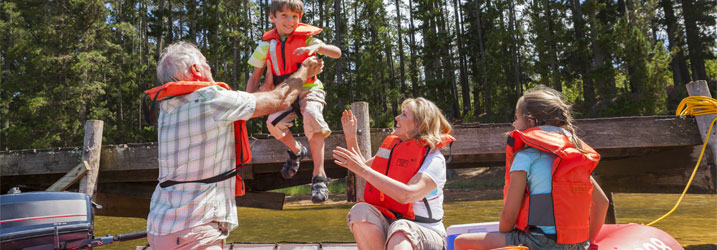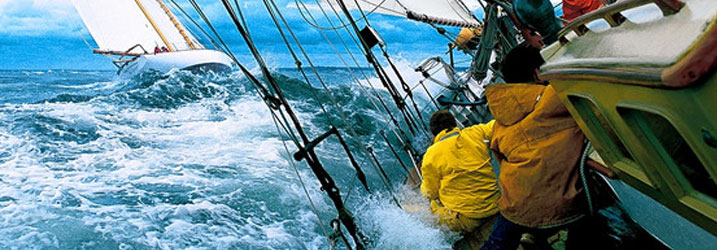
“Man Overboard!”
Most of us, who have taken part in sailing courses, have practiced “Man Overboard” drills, under motor, under sail and usually in calm conditions, no wind, flat seas and plenty of crew to help.
The reality is that many of us sail short-handed, with just our spouse or partner and even with a well-rehearsed plan of action, a successful MOB recovery by one person is very unlikely. Even with a calm sea and no wind, the chill of the water will soon become debilitating and just climbing up a bathing ladder may prove to be a major struggle. Add to this the difficulty of keeping an eye on a body bobbing about in the water while you prepare the rescue gear, the fact that the casualty may be injured or even unconscious and rescue becomes more and more unlikely.
The clear solution is – Don’t go overboard in the first place. “Pretty obvious”, you may say, but something not everyone remembers while out sailing and enjoying themselves.
Wear a lifejacket

There are certain times when a lifejacket should always be worn; on a dinghy, sailboard, PWC or similar, sailing or motoring at night and any time the skipper says it is necessary. It will keep you afloat with your head out of the water and may significantly increase your survival time, but it won’t get you back on board! Lifejackets are however far more comfortable and less bulky than they used to be and in my experience you soon forget you are wearing one.
A few tips to help you stay on board
- One hand for the boat and one for yourself. In other words hold on. Whatever job you are doing leave one hand free for holding on and be prepared to drop what you are carrying if necessary. After all, your life is more important than equipment or clothing. And men – don’t pee overboard, hanging over the stern with an arm round the backstay. Believe it or not, this has been the cause of more MOB incidents than you would credit.
- Grab something solid. Make sure whatever you seize hold of will take your weight. Standing rigging or grab handles are fine but running rigging is not and even guard rails may not be strong enough to hold you.
- Wear a harness and tether. As long as you are clipped on to a strong point well inboard and on a short enough tether, at least this will keep you on board. Two lines enable you to be clipped on at all times. As you move about, transfer your tether from one point to another. Check the stitching regularly, rinse them in clear water after use and dry them well.
- Sensible footwear. Use shoes or boots with good grip on all surfaces, even when wet and avoid bare feet which can result in badly stubbed toes and cuts.
- Your position. Keep low, as you are less likely to lose your balance. There is nothing wrong with using your hands and knees, even if it doesn’t look very “macho”. But try to stay on the windward side of the boat as you will have a better chance of grabbing something solid if necessary.
- Share information. Let your crew know if you are leaving the cockpit to go forward and get them to keep an eye on you. Try to avoid leaving the cockpit if all your crew are below. Warn your crew if you see big waves or swell approaching, especially if they are not in the cockpit.

- Keep warm. It is very easy to get cold, especially if you are feeling sea sick and are reluctant to go below to fetch more clothes. Don’t be afraid of asking someone to collect another layer for you. Being cold slows down your reaction time and takes your mind off safety. Freezing hands don’t grip so well and cold bodies are stiffer and slower to move.
- Don’t carry too much sail. If you’re thinking of reefing – do it straight away. The longer you leave it, the more difficult it will be and the more dangerous. You can shake a reef out far more easily than taking one in.

- Bear away. If you need to steady the boat or level it for someone working on deck, don’t be afraid to bear away from the wind. A little loss of speed is well worth the increased safety.
- Heave to. This is usually a simple operation and is a quick and easy way to stop the boat. It will give you the opportunity to do a quick running repair safely, make it easier for someone moving around the boat, or simply give the crew a moment or two to relax or review a difficult situation.
- The skipper is in charge. As the skipper is in charge of the boat and its crew, he should not hesitate to give clear guidelines on all behaviour around the boat. Similarly the crew should follow the skipper’s instructions, but not be afraid to ask if they do not understand.
- A safe boat. However expert a skipper and crew are, the boat itself should be as safe as possible. There should be enough strong cockpit anchor points for everyone to clip on. Jackstays should be rigged at all times when underway and be strong enough to take the bodyweight of the heaviest crew. Extra grab handles can be fitted to make it safer to move around the boat. Look at slippery areas and apply non-slip tape. Make sure that warps and sheets are not left trailing untidily where crew members might trip over them.
These 12 tips are not a replacement for MOB drill and I would always recommend sailors practicing whenever they can. But bearing them in mind might just make MOB a little more unlikely. Sailing will never be a completely safe sport. Would we want it to be? But keeping safe will at least allow us to carry on taking part in the sport we love.